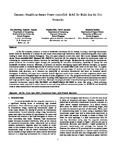Dynamic Neighbour Aware Power-controlled MAC for Multi-hop Ad-hoc networks
| dc.contributor.author | Marchang, Jims | |
| dc.contributor.author | Douglas, R | |
| dc.contributor.author | Ghita, B | |
| dc.contributor.author | Lancaster, D | |
| dc.contributor.author | Sanders, Benjamin | |
| dc.date.accessioned | 2018-07-02T08:08:51Z | |
| dc.date.available | 2018-07-02T08:08:51Z | |
| dc.date.issued | 2018-06 | |
| dc.identifier.issn | 1570-8705 | |
| dc.identifier.issn | 1570-8713 | |
| dc.identifier.uri | http://hdl.handle.net/10026.1/11789 | |
| dc.description.abstract |
In Ad-hoc networks, resources in terms of bandwidth and battery life are limited; so using a fixed high transmission power limits the durability of a battery life and causes unnecessary high interference while communicating with closer nodes leading to lower overall network throughput. Thus, this paper proposes a new cross layer MAC called Dynamic Neighbour Aware Power-controlled MAC (Dynamic NA-PMAC) for multi-hop Ad-hoc networks that adjust the transmission power by estimating the communication distance based on the overheard signal strength. By dynamically controlling the transmission power based on the receivable signal strength, the probability of concurrent transmission, durability of battery life and bandwidth utilization increases. Moreover, in presence of multiple overlapping signals with different strengths, an optimal transmission power is estimated dynamically to maintain fairness and avoid hidden node issues at the same time. In a given area, since power is controlled, the chances of overlapping the sensing ranges of sources and next hop relay nodes or destination node decreases, so it enhances the probability of concurrent transmission and hence an increased overall throughput. In addition, this paper uses a variable backoff algorithm based on the number of active neighbours, which saves energy and increases throughput when the density of active neighbours is less. The designed mechanism is tested with various random network scenarios using different traffic including CBR, Exponential and TCP in both scenarios (stationary and mobile with high speed) for single as well as multi-hop. Moreover, the proposed model is benchmarked against two variants of power-controlled mechanisms namely Min NA-PMAC and MaxRC-MinDA NA-PMAC to prove that using a fixed minimum transmission power may lead to unfair channel access and using different transmission power for RTS/CTS and Data/ACK leads to lower probability of concurrent transmission respectively. | |
| dc.format.extent | 119-134 | |
| dc.language | en | |
| dc.language.iso | en | |
| dc.publisher | Elsevier BV | |
| dc.subject | Ad-hoc | |
| dc.subject | Cross Layer | |
| dc.subject | MAC | |
| dc.subject | Transmission power | |
| dc.subject | QoS | |
| dc.subject | Network Saturation | |
| dc.title | Dynamic Neighbour Aware Power-controlled MAC for Multi-hop Ad-hoc networks | |
| dc.type | journal-article | |
| dc.type | Journal Article | |
| plymouth.author-url | https://www.webofscience.com/api/gateway?GWVersion=2&SrcApp=PARTNER_APP&SrcAuth=LinksAMR&KeyUT=WOS:000433268400009&DestLinkType=FullRecord&DestApp=ALL_WOS&UsrCustomerID=11bb513d99f797142bcfeffcc58ea008 | |
| plymouth.volume | 75-76 | |
| plymouth.publication-status | Published | |
| plymouth.journal | Ad Hoc Networks | |
| dc.identifier.doi | 10.1016/j.adhoc.2018.04.003 | |
| plymouth.organisational-group | /Plymouth | |
| plymouth.organisational-group | /Plymouth/Faculty of Science and Engineering | |
| plymouth.organisational-group | /Plymouth/Faculty of Science and Engineering/School of Engineering, Computing and Mathematics | |
| plymouth.organisational-group | /Plymouth/REF 2021 Researchers by UoA | |
| plymouth.organisational-group | /Plymouth/REF 2021 Researchers by UoA/UoA11 Computer Science and Informatics | |
| plymouth.organisational-group | /Plymouth/Users by role | |
| plymouth.organisational-group | /Plymouth/Users by role/Academics | |
| dc.identifier.eissn | 1570-8713 | |
| dc.rights.embargoperiod | Not known | |
| rioxxterms.versionofrecord | 10.1016/j.adhoc.2018.04.003 | |
| rioxxterms.licenseref.uri | http://www.rioxx.net/licenses/all-rights-reserved | |
| rioxxterms.type | Journal Article/Review |


